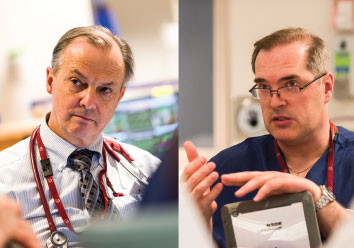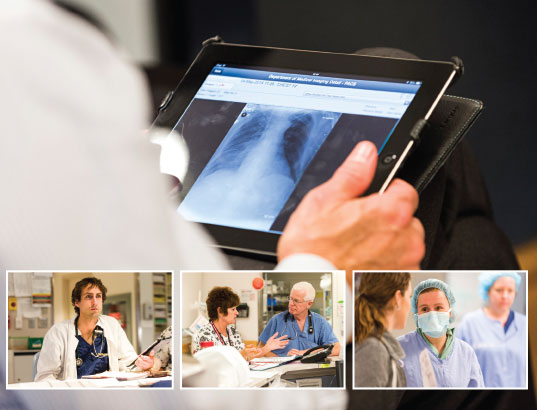Each of this facility’s 19 rooms is packed with a specially tailored collection of equipment, from monitors tracking heart rate and blood pressure, to drug dispensers, to the steadily spinning disc of a kidney dialysis machine that slowly removes waste products from the body. In the most serious cases, an individual’s breathing might be aided by a tube inserted into the mouth, while nutrition may be enabled by another tube delivering food into the stomach. Even the common denominator of a bed can vary from one person to the next, as some are kept warm on inflatable mattresses filled with heated air. All of the necessary and most advanced support strategies for patients are available in the CSICU.
Within this dense forest of technology, people are everywhere. No one is ever alone in the CSICU, which is a perpetual hive of activity. While some cases call for more attention than others, there are nurses, doctors, and technicians working at every hour of the day and night. Above all, they are fully dedicated to this unit.
“When you’re working in the Intensive Care Unit, this is your task,” said Michael Bourke, MD, the principal founder of the CSICU. “You don’t have another job.”

That was among the distinctive features Dr. Bourke built into the operation of the facility when former Heart Institute CEO Wilbert Keon approached him in 1994 to set up an ICU. The move was a response to the growing volume and sophistication of heart surgery that was being carried out.
“Surgery is one aspect of treatment, but the critical care management afterward is at least as significant,” explained Dr. Bourke.
By way of example, he points to the early days of heart transplantation, first performed at the Heart Institute in 1984. By then, the technical niceties of the procedure itself were well honed, but the essential techniques of post-transplantation patient support would take longer for the medical community to refine, ultimately improving patient outcomes.
For instance, transplant patients often suffer from pulmonary hypertension—high pressure in the blood supply to the lungs. The heart’s normally weak right ventricle becomes stronger over time to handle this condition. If a new heart is immediately faced with this challenge, its right ventricle can struggle as it tries to cope with the sudden demand for higher pressure in the transplanted patient. CSICU support strategies can now handle such situations with greater skill and ease. The Heart Institute recently celebrated the 30th anniversary of its heart transplant program. It performed 36 transplants in 2013, the most in Canada, and did so with a 100 per cent survival rate.
This is just one of challenges that can crop up after surgery. The ability to tackle such problems, and arrive at solutions that can help other institutions do the same, has become a hallmark of the CSICU. Dr. Bourke would argue that, in places where staff rotate in and out of the ICU, as good as the resulting work might be, the teams carrying it out will lack the cohesion of a group that works together all the time. Although it sounds paradoxical, the ability of the Heart Institute’s CSICU to stand alone is what makes it such a powerful partner for surgery.
“Interdependence without distraction,” he called it. “In that setting, we are able to develop and change.”
Part of that development stems from an unrivalled record of everything that happens to each patient in the CSICU. “We have extensive data on our pre-operative, inter-operative, and ICU care for all of our cardiac surgeries,” said Dr. Bourke, adding that the 20 years of data now covers some 20,000 patients. “We can look at our care scientifically, administratively, and from a research perspective.” They can continually monitor this information and ask additional questions of it to improve care in myriad ways.
But the immediate priority is always the patient in the bed. For Bernard McDonald, MD, PhD, the current director of the CSICU, a top concern is communication.
“We’re meeting these patients and their families for the very first time under very intense circumstances,” he explained. “They want good information from us; they want us to be frank with them. But most often it’s shared decision making. On the one hand, we know the medical part of it. On their end of it, they know what the patient wants, what their goals are for the surgery. Put those two things together and you can follow a path for recovery.”
Navigating this path is what Care Facilitator and Acting Nurse Manager Gloria Prendergast enjoys about the busy dynamic of the CSICU. She especially enjoys the team culture that makes it possible to routinely handle medical demands that would have been overwhelming and largely impossible just a few decades ago.
“All of us are living longer than ever before,” she said, noting that this also means people are living with degrees of heart disease that might have been rare or unknown in the past. “We’re taking more difficult cases.” Patients also tend to have more complicating health issues. Diabetes, obesity and kidney disease are common contributing conditions that must be managed even as recovery from surgery progresses. This can make care in the CSICU remarkably complex.
In this context, quality of life takes precedence over mere survival, and Prendergast is careful to add that the perception of quality can vary significantly from one person to another. For some, it may simply be the desire to live to see the arrival of a grandchild in the family, while others have much broader plans to return to an active lifestyle. Members of the CSICU are reminded of these distinctions when former patients return for a visit, as they so often do.
“Sometimes you barely recognize them, because they’re so much better,” remarked Prendergast, and the patients are often eager to express their gratitude to the team that in all likelihood saved their lives.
Such occasions work wonders for team morale, according to Dr. Bourke. “These patients might not realize it, but this is important for team-building, which gets an extra boost from these visits,” he said.
Such successful reunions are also a reminder that the CSICU is not simply a place where people go to recover from a serious medical procedure, but a scene of active care that completes a patient’s return to health.
“You’re leading the changes in a patient’s condition, not just observing them,” he concluded. “You’re not a passenger on a ship, you’re the pilot of an airplane.”
Care That Is Varied as Well as Intensive
A planned expansion of the Heart Institute in the next few years will raise the number of beds in the Cardiac Surgery Intensive Care Unit from 19 to at least 25, all of which will be constantly occupied. The patients in these beds have just one goal—getting better—and the CSICU medical team provides several types of highly specialized care that make this recovery possible for many different situations:
Left Ventricle Assist Device (LVAD): In contrast to an artificial heart, which takes over all cardiac functions, an LVAD is a mechanical support device that replaces the operations of just the left ventricle. It is implanted in patients to give their heart muscles time to recover from surgery, or to enhance their survival while they wait for a transplant.
Extracorporeal Membrane Oxygenation (ECMO): Like an LVAD, this is a surgically implanted system, but it provides support to the lungs as well as the heart, potentially for days or weeks. This equipment runs along similar principles to the larger heart-lung bypass machines used for surgery, but an ECMO unit is much more portable. It can help individuals withstand diseases such as severe pneumonia, influenza H1N1 or combined heart-lung failure and keep them stable long enough for recovery or repair.
Renal Care: A substantial number of heart patients also have serious kidney problems. Some of them require dialysis to help them recover from surgery. This blood-cleaning procedure must be carried out in a slow, gentle way, so as not to compromise other aspects of the individual’s health. Doing so has become very manageable, even for the sickest of patients.
Nutrition: A sick body is one that may try to acquire protein from within its own tissues, which is why proper nutrition is essential for ensuring that patients retain their physical strength. The CSICU team includes a full-time nutritionist who uses regular assessments and even measurements of oxygen consumption and carbon dioxide output to determine the optimal type and amount of calories and protein.
Transplants: The success of a heart transplant begins in the operating room and continues in the ICU. The immune system’s potential rejection of the new heart is a well known complication, but a variety of other challenges can emerge after a new heart is in place.
Pulmonary Thromboedarterectomy (PTE): A PTE is an intensive surgical procedure to remove chronic blockages of arteries that feed the lungs. The Heart Institute is one of the few places that can treat this ailment, which must be done through an elaborate surgery to remove the obstruction from the artery. These patients require special ICU care.


